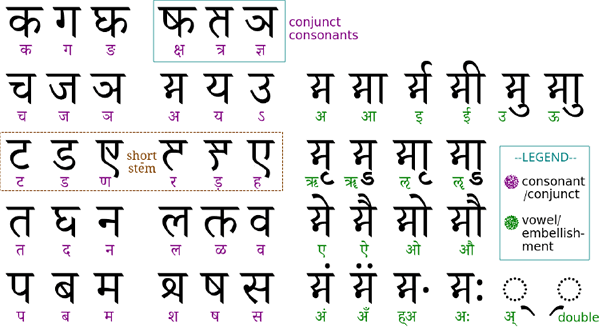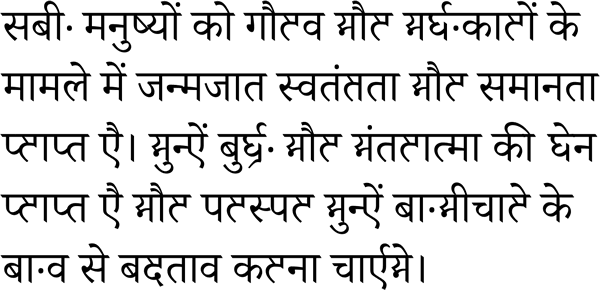
Devadeshi is a simplified and modernised version of the traditional Devanagari script. It was designed by Punya Pranava Pasumarty to write Sanskrit, Hindi and Marathi. It can also be used to write most other Indian languages.
The script is designed to be simpler than Devanagari in the following ways: There are fewer letters and almost no ligatures involved in combining letters (with some exceptions). Vowels are merely marks attached to a letter (including the null consonant / 'vowel holder'), so they don't have individual symbols in isolation. The letters have been stylised such that writing them in succession doesn't cause any break in the topline that joins them.
For those familiar with Devanagari, it can be noticed that some morphemes in Devadeshi look similar to ones in Devanagari, but are entirely different in their function. Keeping in mind this caution, Devadeshi can be learnt with little effort. After all, the differences between Devanagari and Devadeshi are analogous to those between Latin and Cyrillic alphabets.
The consonants featured in Devadeshi are mainly those found in the standard Devanagari script, but excluding aspirated plosives and including flap sounds like ळ and ड़, used in Marathi, as well as a ‘vowel holder’ (null consonant) labelled with ‘अ’ and a variant of that (labelled with ‘ऽ’) used for avagraha and auxillary vowel sounds. There are 3 conjunct consonants used so frequently that they have special ligatures (i.e. क्ष, त्र and ज्ञ of Devanagari), but their glyphs have been modified here for use in Devadeshi. Have a look at the list of letters and vowel marks in the following image:

The letters labelled with purple symbols are consonants or conjunct consonant ligatures and those within the dotted box are ‘short-stem’ letters (discussed later). The one labelled with ‘अ’ is the null consonant or ’vowel holder’ which is used for writing standalone vowels. Those labelled with green symbols are vowel marks (shown adjoined to the null consonant). In addition to the standard vowels found in Sanskrit, there are a few other marks amongst the green labelled ones. The mark labelled as ‘ह्अ’ is the mark used to aspirate a consonant e.g. writing ‘क’ with this mark would be equivalent to ‘ख’. the mark labelled as ‘अ्’ and that labelled as ‘double’ are modifier marks which mute and stress consonants respectively, e.g. ‘क’ with the former becomes ‘क्’, and with the latter, ‘क्क’. When it comes to combinations of letters, vowel marks may be directly combined with consonant letters like in Devanagari. The muted form of a consonant (using the 'अ्' mark) when followed by 1 or more consonants, can be depicted without its vertical stem like in Devanagari, except for the short-stem letters, which form ligatures when combined with the muting mark. Have a look in the following image:

Note that the short stem consonants cannot combine with the ‘double’ mark although they can be stressed by preceding the respective letter with its muted version, like in Devanagari. The last letter listed among the short-stem consonants at the top of the image does not appear in the main alphabet. This is an auxiliary letter used for the Tamil 'ற' sound which does not feature in Hindi, Marathi or Sanskrit. There are more such auxiliary letters shown on the right of the image, which are not short-stem letters. They are labelled with their equivalents in Tamil and Urdu. One of them is the stressed form of 'ற' as indicated by an arrow coming from the latter. Within the dotted box are some special symbols for use in Devadeshi with their Devanagari equivalents.
The auxiliary letters labelled in green are vowels which are peculiar to Tamil and other Indian languages. These represent slightly modified versions of the same marks written when using the ‘vowel holder’ null consonant, so in isolation they are written over the letter labelled as ‘ऽ’ instead. The vowel appends equivalent to these auxiliary vowels, shown towards the bottom-right of the image, are essentially some of the standard vowel marks (as seen earlier) along with the ‘ु’ mark to indicate that the ‘ऽ’ letter is to be used instead of the null consonant to represent these vowels when in isolation.

सभी मनुष्यों को गौरव और अधिकारों के मामले में जन्मजात स्वतन्त्रता और समानता प्राप्त है। उन्हें बुद्धि और अन्तरात्मा की देन प्राप्त है और परस्पर उन्हें भाईचारे के भाव से बर्ताव करना चाहिए।
Sabhī manuṣyōṁ kō gaurava aura adhikārōṁ kē māmalē mēṁ janmajāta svatantratā aura samānatā prāpta hai. Unhēṁ bud'dhi aura antarātmā kī dēna prāpta hai aura paraspara unhēṁ bhā'īcārē kē bhāva sē bartāva karanā cāhi'ē.
All human beings are born free and equal in dignity and rights. They
are endowed with reason and conscience and should act towards one another
in a spirit of brotherhood.
(Article 1 of the Universal Declaration of Human Rights)
Information about Hindi | Phrases | Numbers | Kinship words | Time | Tongue twisters | Tower of Babel | Learning materials | Electronic dicitonaries and translators
Bhāratalipi Unified Indian Script (BLUIS), Charunagari, Deccan Lipi, Devadeshi, Ethiofarsi, Españabugida, Farsi Alefbet, Featural Lojban Abjad, Haruf-e-Tana, Palimukhi, Neobrahmi, SEAscript, West Eurolex
Constructed scripts for: Ainu | Arabic | Chinese languages | Dutch | English | Hawaiian | Hungarian | Japanese | Korean | Lingala | Malay & Indonesian | Persian | Tagalog / Filipino | Russian | Sanskrit | Spanish | Taino | Turkish | Vietnamese | Welsh | Other natural languages | Colour-based scripts | Tactile scripts | Phonetic/universal scripts | Constructed scripts for constructed languages | Adaptations of existing alphabets | Fictional alphabets | Magical alphabets | A-Z index | How to submit a constructed script
[top]
You can support this site by Buying Me A Coffee, and if you like what you see on this page, you can use the buttons below to share it with people you know.

If you like this site and find it useful, you can support it by making a donation via PayPal or Patreon, or by contributing in other ways. Omniglot is how I make my living.
Note: all links on this site to Amazon.com, Amazon.co.uk
and Amazon.fr
are affiliate links. This means I earn a commission if you click on any of them and buy something. So by clicking on these links you can help to support this site.
[top]